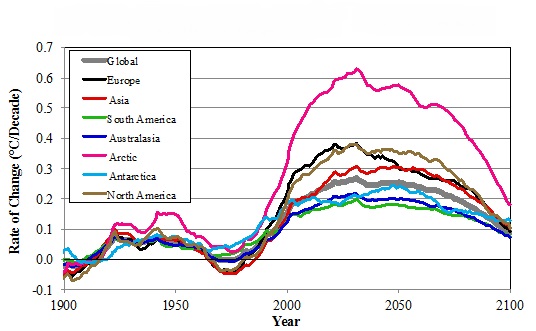EARTH SCIENCES
The climate is starting to change faster

The speed with which temperatures change will continue to increase over the next several decades, intensifying the impacts of climate change
An analysis of changes to the climate that occur over several decades suggests that these changes are happening faster than historical levels and are starting to speed up. The Earth is now entering a period of changing climate that will likely be faster than what's occurred naturally over the last thousand years, according to a new paper in Nature Climate Change, committing people to live through and adapt to a warming world.
In this study, interdisciplinary scientist Steve Smith and colleagues at the Department of Energy's examined historical and projected changes over decades rather than centuries to determine the temperature trends that will be felt by humans alive today.
"We focused on changes over 40-year periods, which is similar to the lifetime of houses and human-built infrastructure such as buildings and roads," said lead author Smith. "In the near term, we're going to have to adapt to these changes."
See CMIP run
Overall, the Earth is getting warmer due to increasing greenhouse gases in the atmosphere that trap heat. But the rise is not smooth — temperatures bob up and down. Although natural changes in temperature have long been studied, less well-understood is how quickly temperatures changed in the past and will change in the future over time scales relevant to society, such as over a person's lifetime. A better grasp of how fast the climate might change could help decision-makers better prepare for its impacts.
To examine rates of change, Smith and colleagues at the Joint Global Change Research Institute, a collaboration between PNNL and the University of Maryland in College Park, turned to the Coupled Model Intercomparison Project. The CMIP combines simulations from over two-dozen climate models from around the world to compare model results.
All the CMIP models used the same data for past and future greenhouse gas concentrations, pollutant emissions, and changes to how land is used, which can emit or take in greenhouse gases. The more models in agreement, the more confidence in the results.
The team calculated how fast temperatures changed between 1850 and 1930, a period when people started keeping records but when the amount of fossil fuel gases collecting in the atmosphere was low. They compared these rates to temperatures reconstructed from natural sources of climate information, such as from tree rings, corals and ice cores, for the past 2,000 years.
Taken together, the shorter time period simulations were similar to the reconstructions over a longer time period, suggesting the models reflected reality well.
While there was little average global temperature increase in this early time period, Earth's temperature fluctuated due to natural variability. Rates of change over 40-year periods in North America and Europe rose and fell as much as 0.2 degrees Celsius per decade. The supercomputer models and the reconstructions largely agreed on these rates of natural variability, indicating the models provide a good representation of trends over a 40-year scale.
Now versus then
Then the team performed a similar analysis using CMIP but calculated 40-year rates of change between 1971 to 2020. They found the average rate of change over North America, for example, to be about 0.3 degrees Celsius per decade, higher than can be accounted for by natural variability. The CMIP models show that, at the present time, most world regions are almost completely outside the natural range for rates of change.
The team also examined how the rates of change would be affected in possible . Climate change picked up speed in the next 40 years in all cases, even in scenarios with lower rates of future greenhouse gas emissions. A scenario where greenhouse gas emissions remained high resulted in high rates of change throughout the rest of this century.
Still, the researchers can't say exactly what impact faster rising temperatures will have on the Earth and its inhabitants.
"In these climate model simulations, the world is just now starting to enter into a new place, where rates of temperature change are consistently larger than historical values over 40-year time spans," said Smith. "We need to better understand what the effects of this will be and how to prepare for them."
